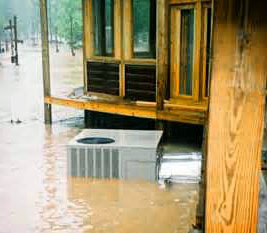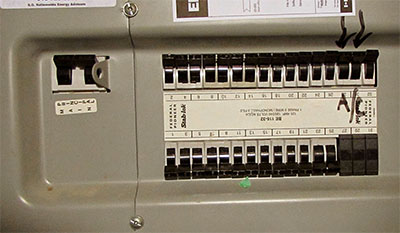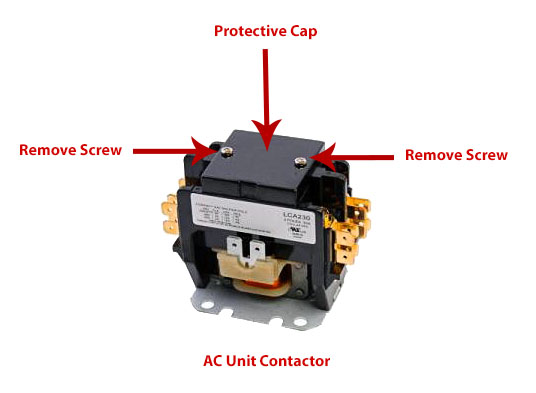
It's August 25th and Houston, TX has some bad weather coming it's way. Hurricane Harvery has been predicted to drop an estimated 20+ inchs of rain in and around the Houston area and cause extensive property damage and flooding. The storm is expected to sit ontop of Houston for days so people have been preparing by purchasing water and other supplies at grocery stores all around town (which are pretty much sold out of everything at this point), but what can we do to prepare our AC system for all of this high water and flooding?
Air Conditioners are designed to be outside and withstand the elements but when the water level gets too high it's simply not safe to have the air conditioner fed any electricity. If your outdoor unit is mounted up high and on stilts or above the ground on a platform, then there should be no issue with the upcoming storm. But if your outdoor AC unit sits on the ground, it should definitely be turned off if the water level begins to rise around the unit. There is anywhere from 240 volts to 480 volts present at all times (even when the unit is not running) at the outdoor unit depending on the neighborhood in Houston, so when the water level starts to get high, it's best to turn off the breaker to the outdoor unit to prevent anything from happening to the unit or anyone around the unit.

The main concern is of course the outdoor unit's compressor. The compressor can be thought of as the heart of your AC system and it's the main (and most expensive) component of the system that pumps and circulates the freon that allows your AC system to cool your home. If for some reason the compressor is activated underwater, it should trip a breaker in your home, but if it doesn't you can expect the compressor to immediately short out (which is going to render it useless). So turn off the breaker if the water level starts to rise so electricity isn't even present at the outdoor unit. You can still however, run the fan on the furnace or indoor air handler unit just to circulate air throughout your home by switching the thermostat into 'Fan On' mode.

Locate the AC breaker and turn it off.
The good news is, if you shut off the power to the outdoor unit, just about everything vital is going to be ok with your system if you let it dry out before turning it back on. HVAC compressors happen to be hermetically sealed, which means no water is going to get inside of the compressor even if it becomes sumberged under water. One thing to keep in mind is if your outdoor unit does get submerged, it definitely needs to dry off before attempting to turn it back on, as the fan motor may have also fill with water so time should be given to allow this to drain out of the motor before turning on the outdoor unit and luckily fan motors actually come with a drain on the bottom just incase any water makes it inside of the motor.
Many of the electrical componenets inside the air conditioning unit are not water proof but they are covered with rain proof caps that keep out the rain but they aren't designed to be completely water proof to the point where they will prevent water from seaping into the areas they cover if they are submerged. If the unit reaches a point where it's underwater, you can just about bet the water is seaping into these electrical areas and seals that are not designed to be submerged under water so these caps need to be removed so the water can drain and these areas need to dry just incase they are full of water.
Locating the protective cover on the contactor
The contactor is where the high voltage coming out of your house is fed into unit itself and it happens to be covered with one of these caps in order to prevent any critters, water, electrical archs from causing any issues with your air conditioner. Since the contactor usually has this protective cap covering it, it can trap water within the contactor and cause major damage if the electricity is fed back to the unit while it's full of water. So the cap needs to be removed to allow the water to drain and the contactor to dry (See below).

Remove the protective cover and allow the contractor to dry.
In order to find your AC units contactor, the power should of course be off and the weather should be nice and dry outside before proceeding. Remember, always test to see if electricity is present before handling any electrical componenets - If your not sure if the power is off (even if you shut off the breaker, as you may have shut off the wrong one!), do NOT proceed and call a friend or a pro who knows how to test if electricity is present at the unit. In order to locate the contactor the AC unit's access/service panel should be opened and you'll notice a bunch of wires and electrical components inside, with the power off, locate the contactor (shown above) and remove the screws that secure the protective cover over the contactor then remove the protective cover. If the contactor is full of water, it needs to dry, and if you notice anything else or any debris from the flood inside the access panel, this should be removed.
Locating the protective cover on the compressor
The compressor is a pretty large componenet of your outdoor air conditioner and sits in the middle of your air conditioner directly under the unit's outdoor fan and it looks just like the one shown below. Just like the contactor, the compressor also a protective cover and rain shield that prevents any rain or critters from coming in contact with the high voltage wires that plug into the side of the compressor which could cause the compressor to electrically short and become ruined. Since this area is rain proof but not completely water proof, water can still get inside if the unit is submerged and become trapped behind the protective cover. So the cover needs to be removed and the area needs to be allowed to dry so once power is restored to the compressor, it doesn't arch around and short out the compressor.

Remove the rain shield and allow the area to dry.
You may have noticed the compressor can be pretty difficult to gain access to and many things are in the way preventing you from even touching it. As always, ensure and test that electricity is not supplied to the unit, even if the breaker is turned off before continuing. After you confirm the electricity is not present you are most likely going to have to remove the top of the unit which should be screwed to the unit's housing all the way around (see below).

The screws securing the top of the air conditioner must be removed all the way around and then the top can be popped off and slid over.
Make sure the power is off and remove the top of the air conditioner which is going to be screwed on. Once unscrewed the entire top can pop off and be slid over, fan and all, and you can finally gain access to the compressor. The protective cover is going to be mounted to the side of the compressor covering the wires that feed into the compressor and can also be difficult to remove. To remove the cover it requires a flat-head screw driver in order to depress and unlock the clips that secure the cover to the compressor. With the power off, use your screw driver to depress the clips and remove the cover all at once. If the area behind the cover is full of water, allow it to become dry and then put the cover back on.

Another thing you can expect to do if the unit floods, is cleaning it's condenser coil which surrounds the outdoor unit. When the unit becomes submerged underwater, the coil is going to become clogged with debris, so turning the AC system back on with a clogged coil is also not a good idea. Once the storm is over, and it's nice and hot again outside, the debris trapped in the coil should be washed away with a water hose.
After all this is complete, allow the unit to dry, including the coil that you just washed off. The caps and covers should be returned back to the componenets they were removed from and everything should be just like it was before you got started cleaning the unit. Make sure the top is properly secured with all it's screws and nothing looks out of place. Grab a small stick or something very thin and spin the fan motor blade to make sure it doesn't come in contact with anything and will spin freely once power is returned to the unit. Once your unit is cleaned, dry, and put back together, you can then proceed to turn the breaker back on and set the thermostat to cool and everything should be fine. As always, if you're not comfortable performing any of these tasks, ask someone who is. If the unit doesn't operate after the storm or after you've cleaned it or if it trips a breaker, feel free to give us a call and we'll glady inspect and repair your unit and show you what to do next time incase your unit ever floods again.
Thanks for reading and good luck out there everyone! Feel free to call us at Adams Air if you have any questions!

